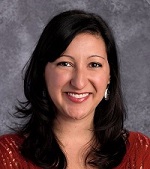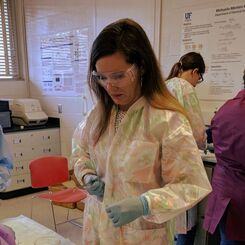Learn With Real Engineers This Summer
Kacie Friberg didn’t know the first thing about pavement – including how it was made – when she arrived at the University of New Hampshire for a National Science Foundation-sponsored paid summer research program for K-12 STEM teachers. “I was a total novice,” the junior high school math teacher from Rye, N.H., says with a laugh, recalling the stack of engineering technical manuals she was handed upon stepping into the lab.
 Friberg not only returned for two more summers of research, she brought back what she had learned from working alongside faculty advisers and graduate student colleagues to transform her classes with real-life engineering inquiry and practices. Among her first big takeaways: to have value, data must be useful. Friberg quickly stopped asking seventh graders to “look at arbitrary data and draw conclusions that mean nothing.” Instead, they now develop research questions, survey two school populations, draw conclusions from their data, and create a poster explaining their findings. Eighth graders learn data acquisition and bivariate regression by creating chocolate “asphalt” with their choice of “aggregates” mixed in, then measuring thickness, time, and terminating load before writing a linear equation to model the relationship of mix and strength. “It’s not just ‘here’s the data, find the mean,’ ” explains Friberg, who presented at a recent conference for NSF Engineering Education and Centers grantees put on by ASEE. “Data has to mean something.” Click HERE to view a PDF of her poster.
Friberg not only returned for two more summers of research, she brought back what she had learned from working alongside faculty advisers and graduate student colleagues to transform her classes with real-life engineering inquiry and practices. Among her first big takeaways: to have value, data must be useful. Friberg quickly stopped asking seventh graders to “look at arbitrary data and draw conclusions that mean nothing.” Instead, they now develop research questions, survey two school populations, draw conclusions from their data, and create a poster explaining their findings. Eighth graders learn data acquisition and bivariate regression by creating chocolate “asphalt” with their choice of “aggregates” mixed in, then measuring thickness, time, and terminating load before writing a linear equation to model the relationship of mix and strength. “It’s not just ‘here’s the data, find the mean,’ ” explains Friberg, who presented at a recent conference for NSF Engineering Education and Centers grantees put on by ASEE. “Data has to mean something.” Click HERE to view a PDF of her poster.
Elementary, middle, and high school teachers across the country are taking their professional learning to the next level through NSF’s Research Experiences for Teachers in Engineering and Computer Science (RET) program. The initiative provides stipends for participants and includes undergraduate or graduate student “partners” in the classroom during the academic year to support the integration of the RET curricular materials into classroom activities. Host universities typically have their own application process and deadlines – typically from January to March – so so check with your local institutions or click HERE for NSF’s map of active RET award sites.
See eGFI’s 2018 post for more details about the RET program’s positive impact on teaching and learning, plus links to several universities that host teachers for summer research.
The impact is not limited to math classes. Friberg, for example, used takeaways from her 2017 research experience comparing the life-cycles of traditional gas versus solar water heaters to overhaul 7th and 8th grade social studies. In “Not-So-Civil Figures,” for instance, students choose an historic individual to research from a variety of perspectives and then tell their story, warts and all. A second summer researching asphalt resulted in a social-emotional learning component in seventh-grade math. Students now identify a problem in their community, design and conduct a survey, analyze their data, and write a letter to a local governing agency using evidence from their research to argue for change.
Mackenzie McNickle, a gifted teacher in the STEM magnet program at Stephen Foster Elementary School in Gainsville, Fla., also presented the results of two consecutive RET experiences at the University of Florida during the NSF grantees conference. In 2018, she was in a aerospace and mechanical engineering lab that focused on the biomedical applications of additive manufacturing. As part of the program, she participated in professional development that helped her improve her understanding of the engineering design process as it applies in the elementary classroom. In 2019, she worked in chemical engineering assistant professor Whitney Stoppel’s biomaterials lab, where she isolated rat tail collagen (photo), studied the applications of silk in biomedicine, and mentored and assisted first year RET teachers in curriculum development. 
How did McNickle boil down such technical material for third and fifth graders? “We focused on STEM practices that professionals do on the job,” she explains. Gone are the fun demonstrations, like erupting volcanoes made from baking soda, that “look cool but have no real purpose,” she tells eGFI Teachers. Instead, students are given “real-world problems and experience failure in a safe environment.” Among the pressing problems her students tackled was figuring out a system for retrieving balls that frequently soared over the schoolyard fence. Despite much brainstorming and promising designs, the most effective prototype only snagged a single ball.
“That was a learning experience in itself,” marvels McNickle. She also has learned from engineering setbacks. RET “taught me to redo my standards so my students could experience what graduate students experience,” she says. Chief among them: failing and presenting to colleagues.
Want to try McNickle’s project-based curriculum in your classroom? Check out the hands-on lesson in designing a way to keep sea-turtles eggs from washing into the sea that she designed for RET and contributed to TeachEngineering’s online libary.
Filed under: Class Activities, For Teachers, Grades K-5, K-12 Outreach Programs, Special Features
Tags: Engineering, NSF, Programs for Teachers, Research Experiences for Teachers in Engineering and Computer Science (RET), Resources for Teachers, Teacher Training








